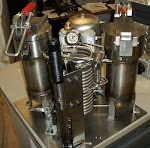The global hydrogen market is about $2.5 billion and growing at a rate of 16% per year. The U.S. share is $1.6 billion, while Europe is at $740 million. This market includes hydrogen generation, storage, distribution and dispensing devices. However, it is important to note that these numbers do not reflect market applications presently using older technologies which could be replaced by hydrogen-based systems and products. Included in this category are the following markets which are being aggressively pursued by API:
- $8 billion market for back-up and auxiliary power consisting of fossil-fuel generators and batteries -- which are ripe for being supplanted by portable and stationary fuel cells powered by hydrogen.
- $150 million market for weather balloons, about $75 million of which is spent on the actual lift gas, now transitioning from scarce helium to abundant and lighter hydrogen.
- $75 million market for Flameless Ration Heaters (FRHs) for military and commercial Meals-Ready-to-Eat (MRE) applications which today use magnesium-based powders that are inferior to aluminum-based powders in terms of performance and cost. Moreover, this number does not include a large emerging European military market for FRHs.
API’s other target hydrogen markets include the following:
- $50 million market for K-Cylinder replacement. This entails lining up industrial gas distributors who will have customers that would prefer API’s PBIS-1000 portable hydrogen generator (see API news release of February 9, 2010) to bulky and pressurized K-Cylinders for field applications, particularly in remote and inaccessible locations.
- $200 million market for international licensing. This entails licensing API’s intellectual property (patents and proprietary know-how) to partners in Europe and Asia for applications in those geographic regions.
- $125 million market in special defense applications. API is working with several companies in addressing new mission-critical applications which are made possible by the use of API’s unique technology as a breakthrough.




No comments:
Post a Comment